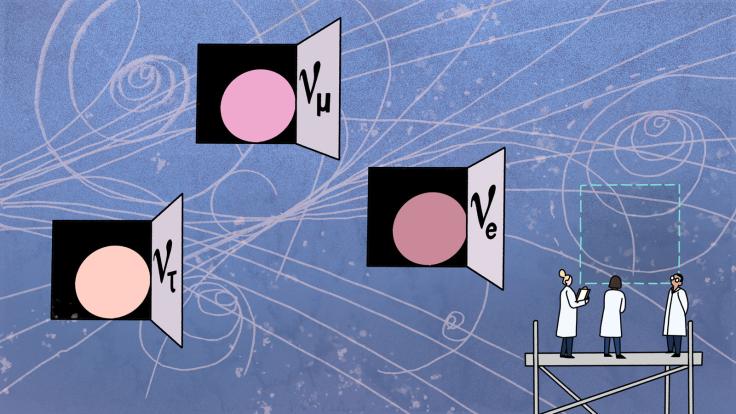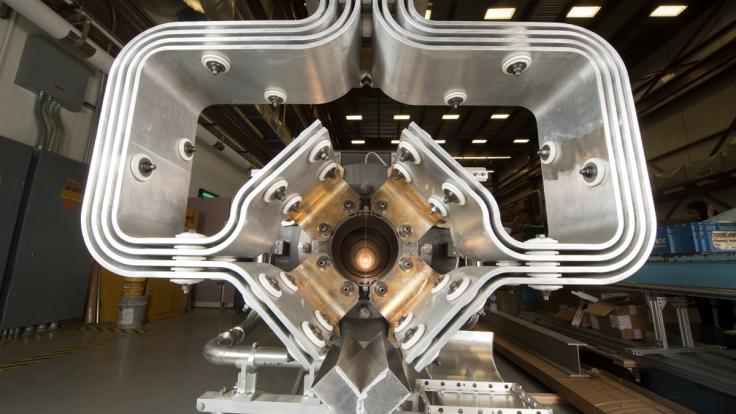Neutrinos are the byproducts of astronomical events that give us life.
They shoot out from the nuclear fusion reaction within the sun and radiate from supernovas. They have no charge and curiously little mass. They are the second most abundant particle in the universe (after photons), and trillions of them are passing through your body each moment.
Yet so much is still unknown about neutrinos.
Among the many open questions about neutrinos is how, exactly, they get their mass; the Standard Model of particle physics does not provide an answer. Many theories that explain the small masses of neutrinos also predict the existence of undiscovered particles, so one way to test those theories is to look for those particles.
Gaining mass the Higgs field way
Most fundamental particles—like quarks and leptons—gain mass via interactions with the Higgs field. Some particles, like the massive top quark, interact more with the Higgs field, while other particles, like the light electron, interact less.
If neutrinos gain their mass from the Higgs field, they seem to interact with it to an even smaller degree than the electron—much smaller; the mass of the neutrino is about a million times lighter.
That alone strikes scientists as strange. But there’s another reason they wonder whether the neutrino gains its mass only from the Higgs.
When a particle interacts with the Higgs field, the Higgs field switches that particle’s “handedness”—a measure of its spin and motion. When a “right-handed” electron interacts with the Higgs field, it becomes a left-handed electron. When a left-handed electron interacts with the Higgs field, the opposite occurs.
But as far as scientists have measured, all neutrinos are left-handed.
Something else seems to be going on, and physicists have dozens of theories about what.
“It’s an embarrassment of riches,” says Tao Han, a theoretical physicist at the University of Pittsburgh. “We have many theories, but we don’t yet know which one reflects nature.”
To get a new particle, use a seesaw
Perhaps the simplest-seeming explanation is that right-handed neutrinos do exist; scientists just haven’t seen them yet.
What’s not simple about this explanation is that those right-handed neutrinos would need to look much different from the neutrinos we know. Whereas neutrinos are almost massless, right-handed neutrinos would likely need to be much more massive than even the heaviest fundamental particle, the top quark.
The explanation for this is called the “seesaw mechanism” because it predicts that the heavy, right-handed neutrinos are the reason left-handed neutrinos are so light; the right-handed neutrinos are holding down one side of the metaphorical seesaw. It all comes down to the math of what physicists call the eigenvalue, a property of how the system behaves. The seesaw model proposes that neutrinos have two eigenvalues, and if one is small, the other must be large to compensate.
Physicists have posited many versions and variations of this mechanism. In one, the right-handed neutrino would be so heavy that it would have been produced only in the early universe, at which point everything was awash in enough energy for the electromagnetic, weak and strong forces to have been unified into one.
In fact, the type of theory that unites these forces—called a Grand Unified Theory—already predicts the existence of right-handed neutrinos.
That kind of built-in reasoning appeals to theoretical physicists like Mu-Chun Chen. “It gives a reason why the right-handed neutrino mass must be heavy and tied to the GUT scale,” says Chen, a professor at the University of California, Irvine. “It’s very elegant.”
A second version of the seesaw mechanism also predicts a new kind of Higgs boson, which would allow a left-handed neutrino to couple to itself and indirectly interact with the new Higgs particle to gain mass. This new Higgs particle would be much heavier, acting as the heavy end of the seesaw. This sort of theory appeals to Han, since the Higgs sector “is still so unknown.”
“Why would we just have one particle that’s responsible for mass generation?” he says. “We have fifteen orders of magnitude between the lightest particle and the heaviest. I think there is more in the Higgs sector than we have seen so far.”
A third version of the seesaw mechanism predicts a new set of other massive matter particles that would offset the low masses of neutrinos.
Physicists have developed models that combine these three, as well as other variants with names like “inverse” and “double” seesaws.
Not everyone is on board with these ideas.
One problem is that the predicted particles are so massive, physicists don’t yet know how to build a particle accelerator powerful enough to study them. “The seesaw mechanism is aptly named after a children’s toy,” says Patrick Huber, theoretical physicist at Virginia Tech. “It’s a classic example of a theory that’s very hard to test and prove.”
Another issue is that all seesaw models predict that the neutrino functions as its own antiparticle. So far, scientists have not seen evidence that this is true. And if it were, it would break another established law of physics called lepton number conservation.
A need to check everywhere—and ask the right questions
Not every theory that explains the small mass of neutrinos is seesaw-related. Another one, called “radiative mass generation,” proposes that neutrinos gain their mass through quantum effects of virtual particles. But radiative mass generation also requires the existence of new particles to work.
So far, no experimental data has directly correlated to any of these models.
“The physics of neutrino mass is like the physics of dark matter, in the sense that we really have almost no idea what dark matter is,” says Pedro Machado, a theoretical physicist at the US Department of Energy’s Fermi National Accelerator Laboratory. “When it comes to neutrino mass models, popularity is not an argument. All viable models are equally good from the point of view of the data.”
That is to say, physicists need more data. “Neutrino theory has a terrible track record in predicting anything,” Huber says. “But we are about to enter an era of precision neutrino measurements, which could be a probe to look for new physics. We have these theories, and if a measurement confirms a theory, it is exciting for the person who made the theory. But if an experiment finds something that nobody predicted, it would be exciting for everybody.”
Physics experiments around the world are trying to understand neutrinos and their masses—and, perhaps, find a sign of a new particle that could help explain it all.
“Since there are so many possibilities, the most useful thing is to cast a wide net and to consider as many different possibilities as we can,” Machado says.
If the explanation winds up pushing physics beyond our current understanding, he says, “then that is what we have been waiting for.”














